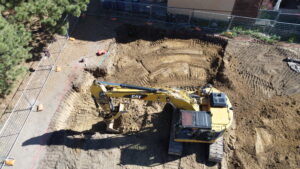Recently, we’ve had a few projects where our post-tension elongations came up longer than expected. As you’ll recall from my post earlier this year, elongation review is a critical part of an engineer’s acceptance of a post-tension slab. However, I mostly concentrated on short pulls in that article. What happens when the tendons pull long?
As I explained earlier, post-tension stressing pumps are calibrated before they reach the jobsite to a pressure corresponding to 33.0 kips. This is 80% of the yield strength of the tendon — essentially, the most the strand can be stretched without permanently deforming, while still leaving a factor of safety. Also, as explained earlier, the “anchor set” is a value that comes straight off the top of the elongation, instantly reducing the force in the tendon. This acts as an additional factor of safety.
Since the usual concern with elongation reports is understressed tendons, the occasional long tendon isn’t a cause for great concern. We still check them — they’re out of specification, after all — but once you know the line that translates into permanent damage for the tendon (don’t forget anchor set!), a single tendon that’s a bit long isn’t a real issue.
What if several tendons (especially tendons bundled together) are over-length? Step one is to check to make sure the elongation from the shop drawings is accurate. The difference between 5 7/8″ and 2 7/8″ can be as insignificant as a typographical error. Which is certainly true in both directions — and is why the calibrated gauge pressure is the first criteria for acceptance of the post-tensioning force. 
So, barring typographical errors on the shop drawings, what causes over-elongation? While each of the factors I mentioned in my original discussion of elongations can end up being less of a reduction than normal — potentially adding up to an over-specification elongation — the most common problem is over-stressing. That’s why the factor of safety is 20% (instead of 15%), and why almost all post-tensioning pumps are equipped with a pressure-relief valve. Common procedure is to set that valve to prevent the pump from turning out more than about 90% of the tendon’s yield strength. It is critical that only the jack supplier adjust this valve! There are no good results from adjusting this valve in the field. It may even void the jack’s calibration.
Now, I’ve said that we check every elongation, and that we’re very much aware of the upper edge of potential non-damaging elongations. What happens when a tendon is over the line?
First, the Engineer of Record will request the mill certificates for the tendon in question. Each batch of strand is tested before it ever leaves the mill, in order to determine it’s actual yield stress, area, and modulus of elasticity. About half the time (in my experience) the yield strength is higher than nominal, or the strand is just a little bit oversized — both of which help justify leaving the tendon as-is.
If the Engineer of Record cannot justify the tendon’s acceptability, he’s forced to abandon it. Assuming that it provides no precompression or balanced load, he rechecks his calculations — and looks for any slight overages in the nearby tendons to help. Did he need 18 tendons, or just 17.6? Do those 18 tendons give him 27 kips per strand, or 27.1? Does the slab work with 143 psi of precompression in this bay, rather than 160 psi specified?
If, after careful checking, the slab doesn’t meet the engineer’s criteria, the tendon may have to be replaced. At best, it’s a dirty, labor-intensive process that’s prone to false starts; at worst, it’s invasive and dangerous. EVstudio will always do our best to avoid tendon replacements, but we have to make sure the building is safe. Help us help you by always stressing to calibrated gauge pressure . . . and do not adjust the pressure relief valve!










